
The giant squid isn’t just a figment of folklore; it plays an important role in the ocean’s ecosystem. Yet, like many creatures in our oceans, it’s vulnerable to various threats. These threats may come from natural predators, environmental changes, and human activities. By diving into this topic, we can explore how these factors affect the giant squid and what they mean for the future of this incredible species.
Natural Predators of the Giant Squid
One of the main threats to giant squids comes from their natural predators. While adult giant squids are pretty large and fearsome in their own right, they’re not at the top of the food chain. You might think of the sperm whale—the giant squid’s most notorious foe. These massive marine mammals dive deep into the ocean to hunt their prey, and they’re well-equipped to tackle giant squids.
Sperm whales can dive over a mile deep in search of food, making them a significant threat. They have a knack for locating giant squids using echolocation, which is like their personal sonar system. With their powerful jaws and sharp teeth, they can easily capture and consume these large cephalopods. So, while the giant squid may be a formidable creature, it still has to watch out for these deep-sea giants.
Other predators include large fish species and even other squids. Young giant squids are particularly vulnerable to smaller predators, including various shark species. Because of this predator-prey relationship, it’s essential for giant squids to stay hidden in the depths, using their camouflage skills to blend into their surroundings.
Climate Change and Its Impact
Climate change is another significant threat to the giant squid and its habitat. As global temperatures rise, ocean temperatures also change, which can impact the entire marine ecosystem. Warmer waters can lead to changes in food availability, altering the distribution of prey that giant squids rely on to survive.
For instance, many smaller fish that giant squids like to eat may move to cooler waters, leaving the squids in search of food. This displacement can disrupt their feeding patterns and make it harder for them to find sustenance. Imagine trying to hunt for your favorite meal, only to find out that it’s moved to a different country—it’s tough!
Moreover, climate change also affects the ocean’s acidity levels. Increased CO2 absorption leads to more acidic waters, which can harm marine life, including squid species. The squids’ delicate bodies could face challenges in growth and reproduction due to these changing conditions, ultimately threatening their populations in the wild.
Pollution and Its Effects on Ocean Life
Pollution is a pervasive issue that threatens countless marine species, including the giant squid. Toxic waste, plastic debris, and chemical runoff from land can make their way into the ocean, creating hazardous environments. When these harmful substances enter the water, they can have dire consequences for all marine life.
For giant squids, pollution can affect them on multiple levels. First, it can contaminate their food supply, leading to health problems for squids that consume infected prey. Imagine eating a meal that’s been tainted—you’d definitely feel sick! Second, pollution can disrupt their delicate breeding habitats. If their spawning grounds are contaminated, it could hinder their ability to reproduce effectively.
With plastic pollution on the rise, many marine animals mistake debris for food. Although giant squids are less likely to consume plastic directly due to their preferred diet, the larger issue of trash in the oceans can create dangerous environments where squids might become trapped or injured.
Overfishing and Depletion of Food Sources
Overfishing is a significant concern that indirectly threatens giant squids. When commercial fisheries target smaller fish species that squids rely on, it can lead to a depletion of their food sources. This situation sets off a chain reaction in the ecosystem, affecting not just the squid population but the entire marine food web.
As fishermen catch more fish than can be naturally replenished, squids find themselves competing for a shrinking food supply. This is like trying to find a seat at a crowded restaurant: the less food there is available, the more difficult it becomes for squids to thrive. Over time, if key fish populations decline, it could also affect the giant squid’s reproductive success, leading to fewer squids in the ocean.
Efforts to manage fish populations sustainably are essential in addressing this issue. Practices that promote balanced ecosystems help ensure that giant squids and other marine species can coexist and flourish in their natural habitats.
Human Activities and Their Consequences
Human activities extend beyond just fishing and pollution. The development of coastal areas, shipping lanes, and deep-sea mining all contribute to threats faced by giant squids. These activities can disrupt their natural habitats and mating grounds, making it harder for squids to survive and reproduce.
For instance, noise pollution from boats and ships can disturb squid communication and hunting behaviors. They rely on echolocation and other sounds to navigate their environment. Picture yourself in a loud, bustling café, trying to have a conversation—it’s frustrating, right? The same goes for squids trying to hunt or communicate in noisy waters.
Moreover, habitat destruction due to coastal development can lead to loss of breeding and feeding grounds. If we’re not careful about how we treat our oceans, we risk affecting not only the giant squid population but the entire ecosystem they are part of.
Conservation Efforts and Future Outlook
Understanding these threats is the first step toward protecting the giant squid. Various organizations are working diligently to conserve ocean habitats and raise awareness about the importance of these remarkable creatures. Education and advocacy can help change public perceptions about the ocean and its inhabitants, making it a priority for communities to care for marine ecosystems.
One approach is promoting sustainable fishing practices, ensuring that fish populations remain stable while allowing squids to flourish. Additionally, reducing pollution through better waste management and encouraging ocean clean-up initiatives can significantly improve squid habitats.
With ongoing research, scientists are continually learning more about the giant squid and its ecosystem. This knowledge can inform conservation strategies and help protect these incredible animals.
In conclusion, while the giant squid seems like a mysterious and fascinating creature of the deep, it faces many real threats in its environment. By understanding these issues, we can take steps to help ensure the survival of giant squids and the health of our oceans. After all, the future of these majestic creatures depends on our willingness to protect their watery home.

